Organisational Behaviour Essay: Motivating Employees Through Teamwork
VerifiedAdded on 2020/12/18
|8
|2247
|168
Essay
AI Summary
This essay delves into the crucial role of teamwork in motivating employees within organizations. It begins by defining teamwork and its significance in fostering company culture, boosting employee performance, and enhancing overall motivation. The essay then explores various motivational theories, including Maslow's hierarchy of needs, Herzberg's two-factor theory, and Adam's equity theory, explaining how these theories contribute to understanding and addressing employee needs and expectations. The main body of the essay discusses how organizations can implement these theories to improve employee engagement, job satisfaction, and overall performance. It also highlights strategies for motivating team members, such as providing fair compensation, fostering a positive work environment, offering opportunities for skill development, and promoting open communication and trust. The essay concludes by summarizing the key findings and emphasizing the importance of teamwork and motivational theories in achieving organizational goals and creating a productive and engaged workforce.
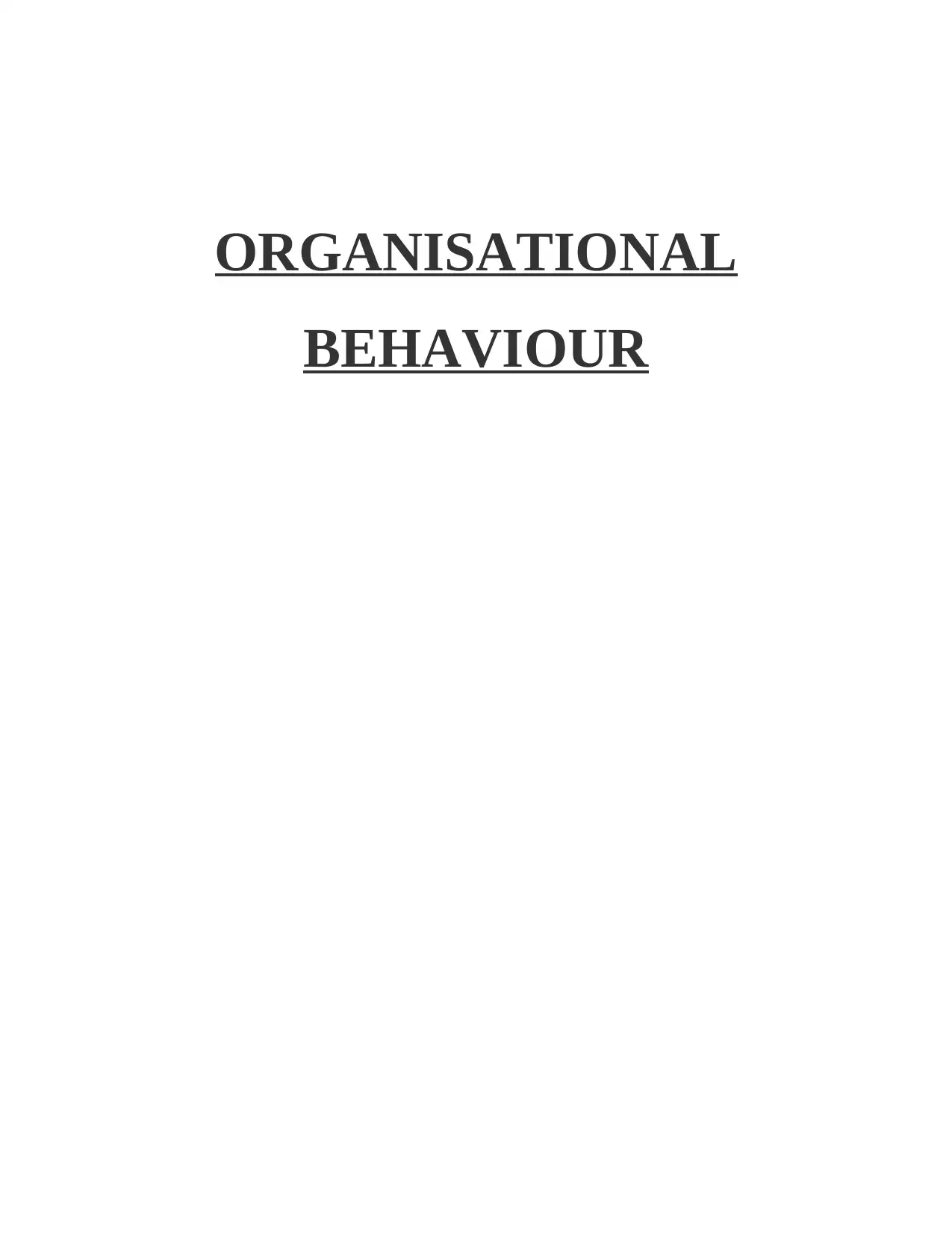
ORGANISATIONAL
BEHAVIOUR
BEHAVIOUR
Paraphrase This Document
Need a fresh take? Get an instant paraphrase of this document with our AI Paraphraser
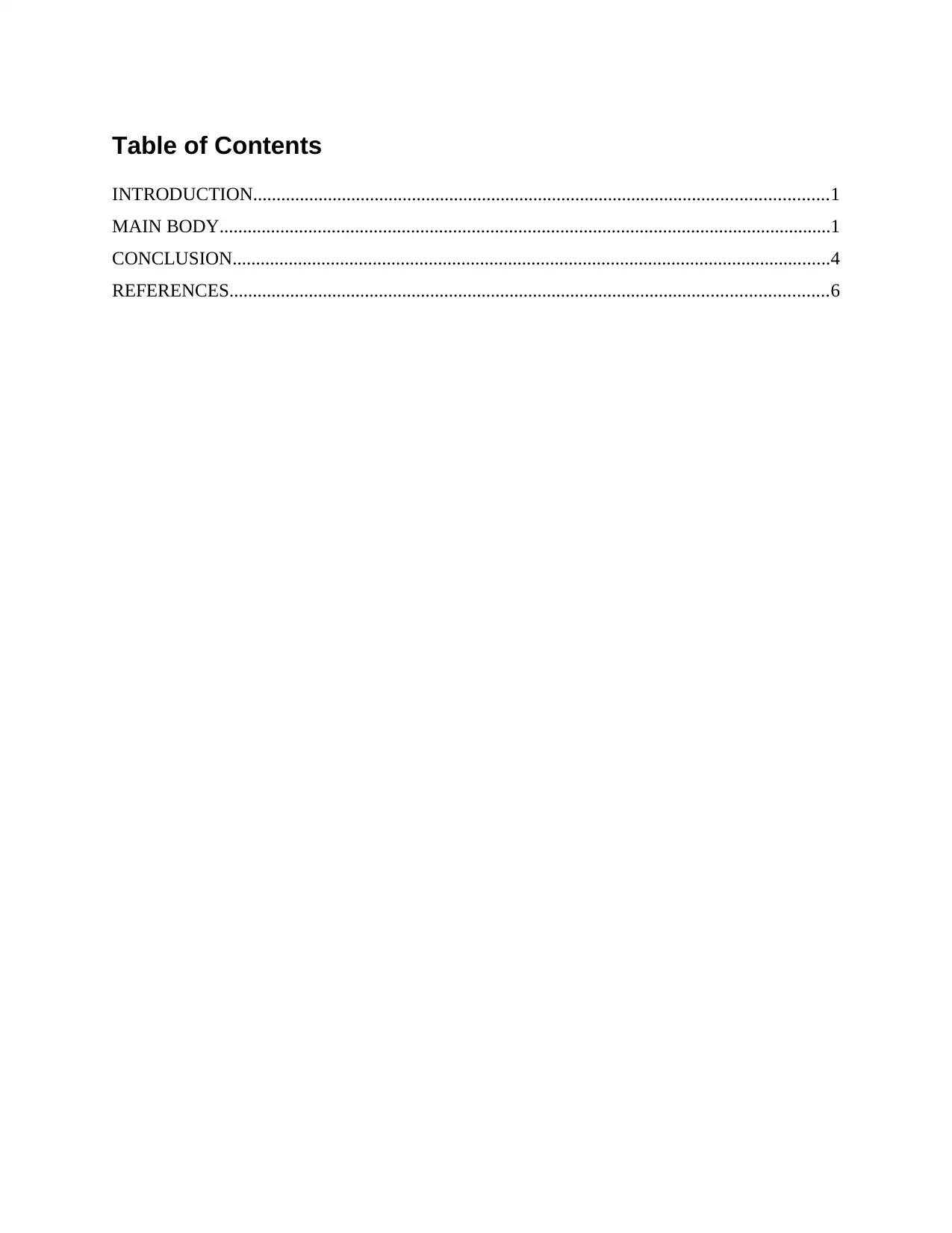
Table of Contents
INTRODUCTION...........................................................................................................................1
MAIN BODY...................................................................................................................................1
CONCLUSION................................................................................................................................4
REFERENCES................................................................................................................................6
INTRODUCTION...........................................................................................................................1
MAIN BODY...................................................................................................................................1
CONCLUSION................................................................................................................................4
REFERENCES................................................................................................................................6
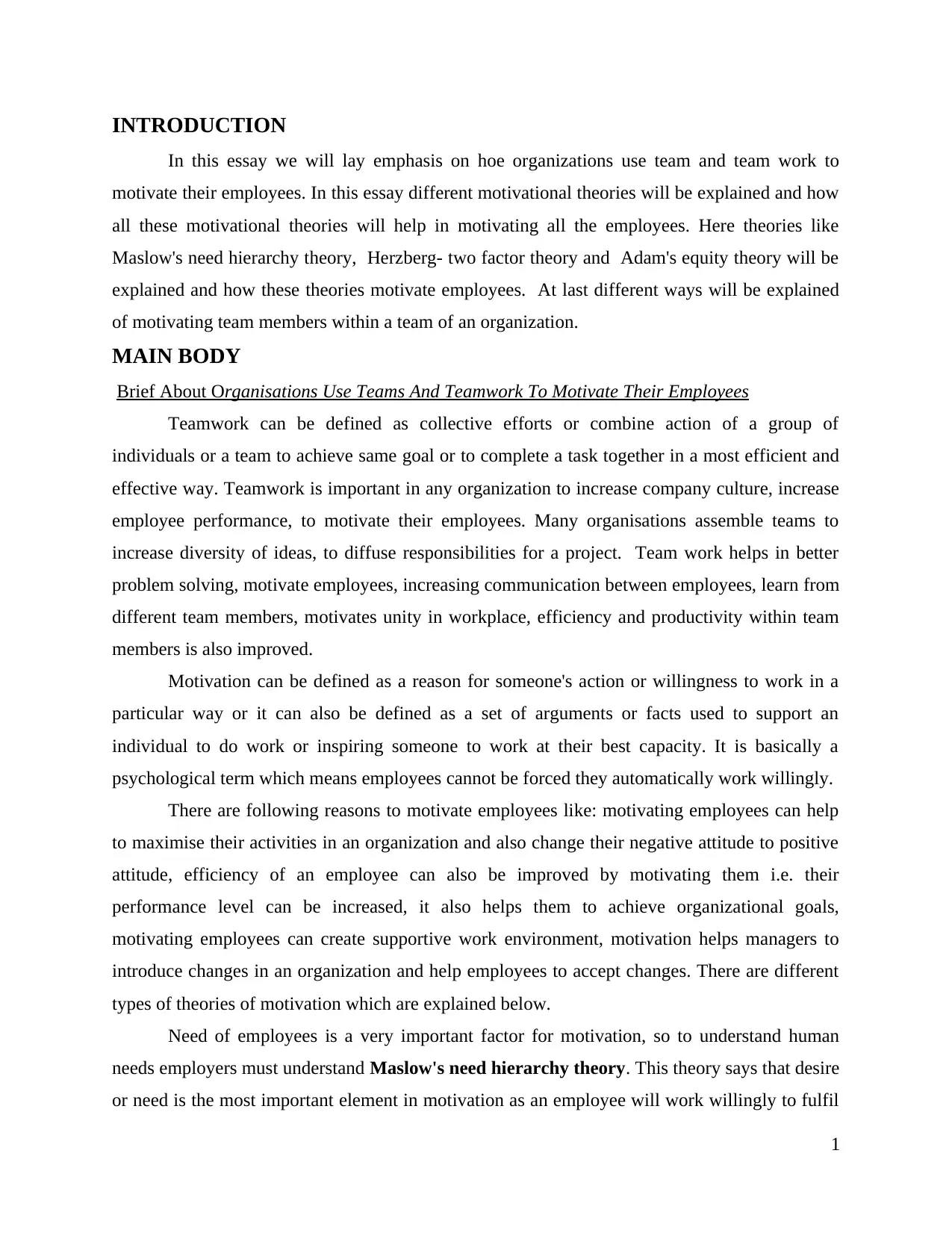
INTRODUCTION
In this essay we will lay emphasis on hoe organizations use team and team work to
motivate their employees. In this essay different motivational theories will be explained and how
all these motivational theories will help in motivating all the employees. Here theories like
Maslow's need hierarchy theory, Herzberg- two factor theory and Adam's equity theory will be
explained and how these theories motivate employees. At last different ways will be explained
of motivating team members within a team of an organization.
MAIN BODY
Brief About Organisations Use Teams And Teamwork To Motivate Their Employees
Teamwork can be defined as collective efforts or combine action of a group of
individuals or a team to achieve same goal or to complete a task together in a most efficient and
effective way. Teamwork is important in any organization to increase company culture, increase
employee performance, to motivate their employees. Many organisations assemble teams to
increase diversity of ideas, to diffuse responsibilities for a project. Team work helps in better
problem solving, motivate employees, increasing communication between employees, learn from
different team members, motivates unity in workplace, efficiency and productivity within team
members is also improved.
Motivation can be defined as a reason for someone's action or willingness to work in a
particular way or it can also be defined as a set of arguments or facts used to support an
individual to do work or inspiring someone to work at their best capacity. It is basically a
psychological term which means employees cannot be forced they automatically work willingly.
There are following reasons to motivate employees like: motivating employees can help
to maximise their activities in an organization and also change their negative attitude to positive
attitude, efficiency of an employee can also be improved by motivating them i.e. their
performance level can be increased, it also helps them to achieve organizational goals,
motivating employees can create supportive work environment, motivation helps managers to
introduce changes in an organization and help employees to accept changes. There are different
types of theories of motivation which are explained below.
Need of employees is a very important factor for motivation, so to understand human
needs employers must understand Maslow's need hierarchy theory. This theory says that desire
or need is the most important element in motivation as an employee will work willingly to fulfil
1
In this essay we will lay emphasis on hoe organizations use team and team work to
motivate their employees. In this essay different motivational theories will be explained and how
all these motivational theories will help in motivating all the employees. Here theories like
Maslow's need hierarchy theory, Herzberg- two factor theory and Adam's equity theory will be
explained and how these theories motivate employees. At last different ways will be explained
of motivating team members within a team of an organization.
MAIN BODY
Brief About Organisations Use Teams And Teamwork To Motivate Their Employees
Teamwork can be defined as collective efforts or combine action of a group of
individuals or a team to achieve same goal or to complete a task together in a most efficient and
effective way. Teamwork is important in any organization to increase company culture, increase
employee performance, to motivate their employees. Many organisations assemble teams to
increase diversity of ideas, to diffuse responsibilities for a project. Team work helps in better
problem solving, motivate employees, increasing communication between employees, learn from
different team members, motivates unity in workplace, efficiency and productivity within team
members is also improved.
Motivation can be defined as a reason for someone's action or willingness to work in a
particular way or it can also be defined as a set of arguments or facts used to support an
individual to do work or inspiring someone to work at their best capacity. It is basically a
psychological term which means employees cannot be forced they automatically work willingly.
There are following reasons to motivate employees like: motivating employees can help
to maximise their activities in an organization and also change their negative attitude to positive
attitude, efficiency of an employee can also be improved by motivating them i.e. their
performance level can be increased, it also helps them to achieve organizational goals,
motivating employees can create supportive work environment, motivation helps managers to
introduce changes in an organization and help employees to accept changes. There are different
types of theories of motivation which are explained below.
Need of employees is a very important factor for motivation, so to understand human
needs employers must understand Maslow's need hierarchy theory. This theory says that desire
or need is the most important element in motivation as an employee will work willingly to fulfil
1
⊘ This is a preview!⊘
Do you want full access?
Subscribe today to unlock all pages.

Trusted by 1+ million students worldwide
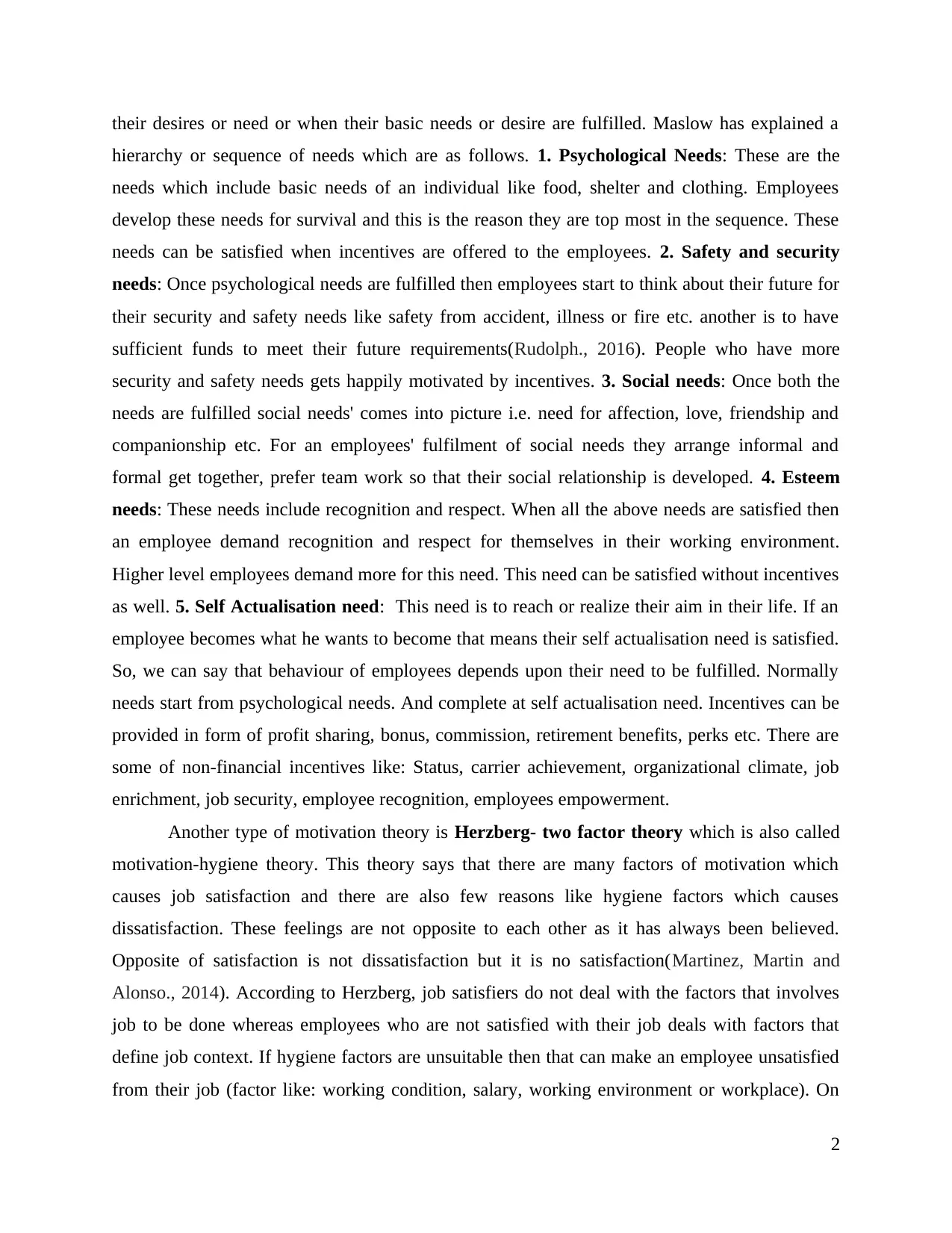
their desires or need or when their basic needs or desire are fulfilled. Maslow has explained a
hierarchy or sequence of needs which are as follows. 1. Psychological Needs: These are the
needs which include basic needs of an individual like food, shelter and clothing. Employees
develop these needs for survival and this is the reason they are top most in the sequence. These
needs can be satisfied when incentives are offered to the employees. 2. Safety and security
needs: Once psychological needs are fulfilled then employees start to think about their future for
their security and safety needs like safety from accident, illness or fire etc. another is to have
sufficient funds to meet their future requirements(Rudolph., 2016). People who have more
security and safety needs gets happily motivated by incentives. 3. Social needs: Once both the
needs are fulfilled social needs' comes into picture i.e. need for affection, love, friendship and
companionship etc. For an employees' fulfilment of social needs they arrange informal and
formal get together, prefer team work so that their social relationship is developed. 4. Esteem
needs: These needs include recognition and respect. When all the above needs are satisfied then
an employee demand recognition and respect for themselves in their working environment.
Higher level employees demand more for this need. This need can be satisfied without incentives
as well. 5. Self Actualisation need: This need is to reach or realize their aim in their life. If an
employee becomes what he wants to become that means their self actualisation need is satisfied.
So, we can say that behaviour of employees depends upon their need to be fulfilled. Normally
needs start from psychological needs. And complete at self actualisation need. Incentives can be
provided in form of profit sharing, bonus, commission, retirement benefits, perks etc. There are
some of non-financial incentives like: Status, carrier achievement, organizational climate, job
enrichment, job security, employee recognition, employees empowerment.
Another type of motivation theory is Herzberg- two factor theory which is also called
motivation-hygiene theory. This theory says that there are many factors of motivation which
causes job satisfaction and there are also few reasons like hygiene factors which causes
dissatisfaction. These feelings are not opposite to each other as it has always been believed.
Opposite of satisfaction is not dissatisfaction but it is no satisfaction(Martinez, Martin and
Alonso., 2014). According to Herzberg, job satisfiers do not deal with the factors that involves
job to be done whereas employees who are not satisfied with their job deals with factors that
define job context. If hygiene factors are unsuitable then that can make an employee unsatisfied
from their job (factor like: working condition, salary, working environment or workplace). On
2
hierarchy or sequence of needs which are as follows. 1. Psychological Needs: These are the
needs which include basic needs of an individual like food, shelter and clothing. Employees
develop these needs for survival and this is the reason they are top most in the sequence. These
needs can be satisfied when incentives are offered to the employees. 2. Safety and security
needs: Once psychological needs are fulfilled then employees start to think about their future for
their security and safety needs like safety from accident, illness or fire etc. another is to have
sufficient funds to meet their future requirements(Rudolph., 2016). People who have more
security and safety needs gets happily motivated by incentives. 3. Social needs: Once both the
needs are fulfilled social needs' comes into picture i.e. need for affection, love, friendship and
companionship etc. For an employees' fulfilment of social needs they arrange informal and
formal get together, prefer team work so that their social relationship is developed. 4. Esteem
needs: These needs include recognition and respect. When all the above needs are satisfied then
an employee demand recognition and respect for themselves in their working environment.
Higher level employees demand more for this need. This need can be satisfied without incentives
as well. 5. Self Actualisation need: This need is to reach or realize their aim in their life. If an
employee becomes what he wants to become that means their self actualisation need is satisfied.
So, we can say that behaviour of employees depends upon their need to be fulfilled. Normally
needs start from psychological needs. And complete at self actualisation need. Incentives can be
provided in form of profit sharing, bonus, commission, retirement benefits, perks etc. There are
some of non-financial incentives like: Status, carrier achievement, organizational climate, job
enrichment, job security, employee recognition, employees empowerment.
Another type of motivation theory is Herzberg- two factor theory which is also called
motivation-hygiene theory. This theory says that there are many factors of motivation which
causes job satisfaction and there are also few reasons like hygiene factors which causes
dissatisfaction. These feelings are not opposite to each other as it has always been believed.
Opposite of satisfaction is not dissatisfaction but it is no satisfaction(Martinez, Martin and
Alonso., 2014). According to Herzberg, job satisfiers do not deal with the factors that involves
job to be done whereas employees who are not satisfied with their job deals with factors that
define job context. If hygiene factors are unsuitable then that can make an employee unsatisfied
from their job (factor like: working condition, salary, working environment or workplace). On
2
Paraphrase This Document
Need a fresh take? Get an instant paraphrase of this document with our AI Paraphraser
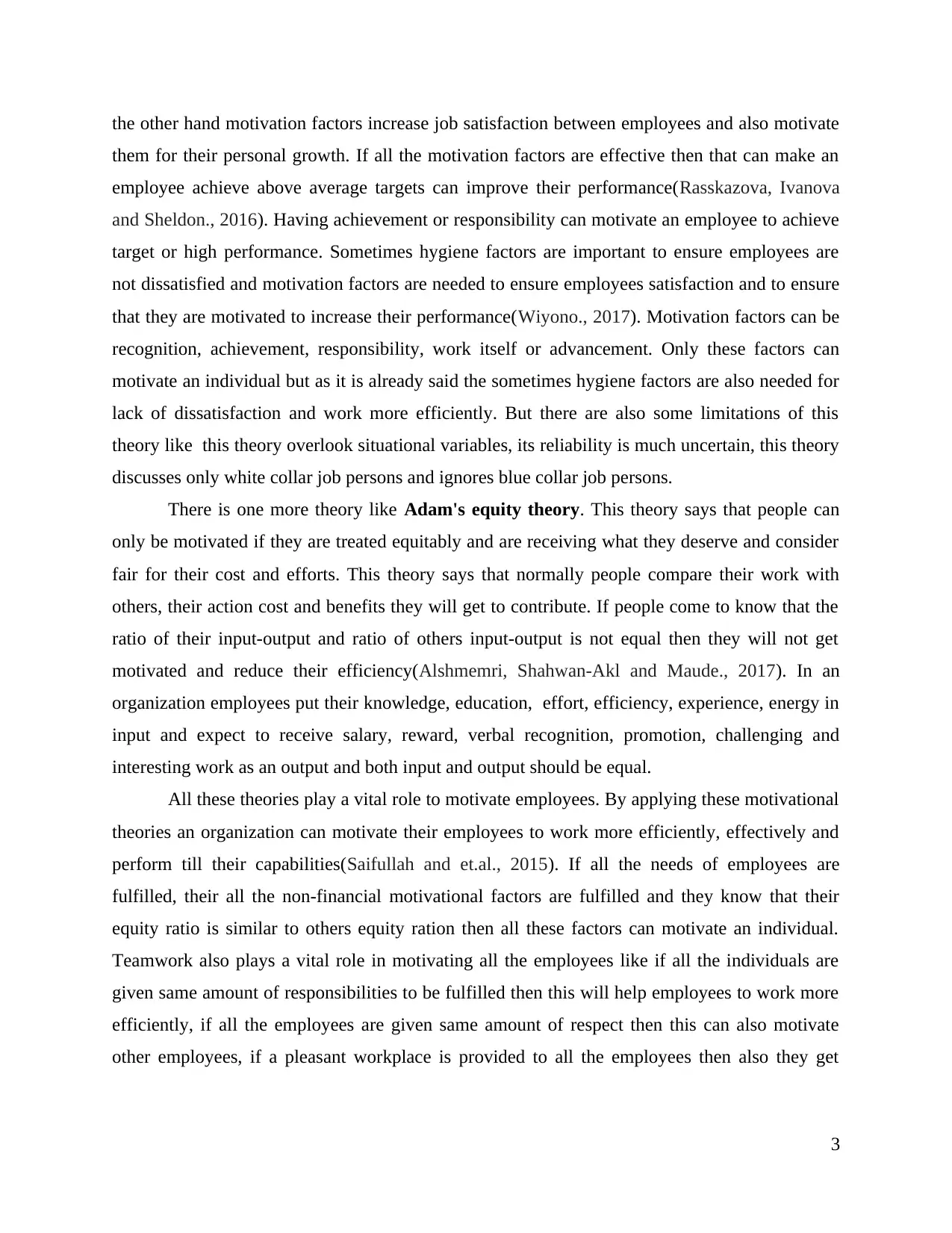
the other hand motivation factors increase job satisfaction between employees and also motivate
them for their personal growth. If all the motivation factors are effective then that can make an
employee achieve above average targets can improve their performance(Rasskazova, Ivanova
and Sheldon., 2016). Having achievement or responsibility can motivate an employee to achieve
target or high performance. Sometimes hygiene factors are important to ensure employees are
not dissatisfied and motivation factors are needed to ensure employees satisfaction and to ensure
that they are motivated to increase their performance(Wiyono., 2017). Motivation factors can be
recognition, achievement, responsibility, work itself or advancement. Only these factors can
motivate an individual but as it is already said the sometimes hygiene factors are also needed for
lack of dissatisfaction and work more efficiently. But there are also some limitations of this
theory like this theory overlook situational variables, its reliability is much uncertain, this theory
discusses only white collar job persons and ignores blue collar job persons.
There is one more theory like Adam's equity theory. This theory says that people can
only be motivated if they are treated equitably and are receiving what they deserve and consider
fair for their cost and efforts. This theory says that normally people compare their work with
others, their action cost and benefits they will get to contribute. If people come to know that the
ratio of their input-output and ratio of others input-output is not equal then they will not get
motivated and reduce their efficiency(Alshmemri, Shahwan-Akl and Maude., 2017). In an
organization employees put their knowledge, education, effort, efficiency, experience, energy in
input and expect to receive salary, reward, verbal recognition, promotion, challenging and
interesting work as an output and both input and output should be equal.
All these theories play a vital role to motivate employees. By applying these motivational
theories an organization can motivate their employees to work more efficiently, effectively and
perform till their capabilities(Saifullah and et.al., 2015). If all the needs of employees are
fulfilled, their all the non-financial motivational factors are fulfilled and they know that their
equity ratio is similar to others equity ration then all these factors can motivate an individual.
Teamwork also plays a vital role in motivating all the employees like if all the individuals are
given same amount of responsibilities to be fulfilled then this will help employees to work more
efficiently, if all the employees are given same amount of respect then this can also motivate
other employees, if a pleasant workplace is provided to all the employees then also they get
3
them for their personal growth. If all the motivation factors are effective then that can make an
employee achieve above average targets can improve their performance(Rasskazova, Ivanova
and Sheldon., 2016). Having achievement or responsibility can motivate an employee to achieve
target or high performance. Sometimes hygiene factors are important to ensure employees are
not dissatisfied and motivation factors are needed to ensure employees satisfaction and to ensure
that they are motivated to increase their performance(Wiyono., 2017). Motivation factors can be
recognition, achievement, responsibility, work itself or advancement. Only these factors can
motivate an individual but as it is already said the sometimes hygiene factors are also needed for
lack of dissatisfaction and work more efficiently. But there are also some limitations of this
theory like this theory overlook situational variables, its reliability is much uncertain, this theory
discusses only white collar job persons and ignores blue collar job persons.
There is one more theory like Adam's equity theory. This theory says that people can
only be motivated if they are treated equitably and are receiving what they deserve and consider
fair for their cost and efforts. This theory says that normally people compare their work with
others, their action cost and benefits they will get to contribute. If people come to know that the
ratio of their input-output and ratio of others input-output is not equal then they will not get
motivated and reduce their efficiency(Alshmemri, Shahwan-Akl and Maude., 2017). In an
organization employees put their knowledge, education, effort, efficiency, experience, energy in
input and expect to receive salary, reward, verbal recognition, promotion, challenging and
interesting work as an output and both input and output should be equal.
All these theories play a vital role to motivate employees. By applying these motivational
theories an organization can motivate their employees to work more efficiently, effectively and
perform till their capabilities(Saifullah and et.al., 2015). If all the needs of employees are
fulfilled, their all the non-financial motivational factors are fulfilled and they know that their
equity ratio is similar to others equity ration then all these factors can motivate an individual.
Teamwork also plays a vital role in motivating all the employees like if all the individuals are
given same amount of responsibilities to be fulfilled then this will help employees to work more
efficiently, if all the employees are given same amount of respect then this can also motivate
other employees, if a pleasant workplace is provided to all the employees then also they get
3
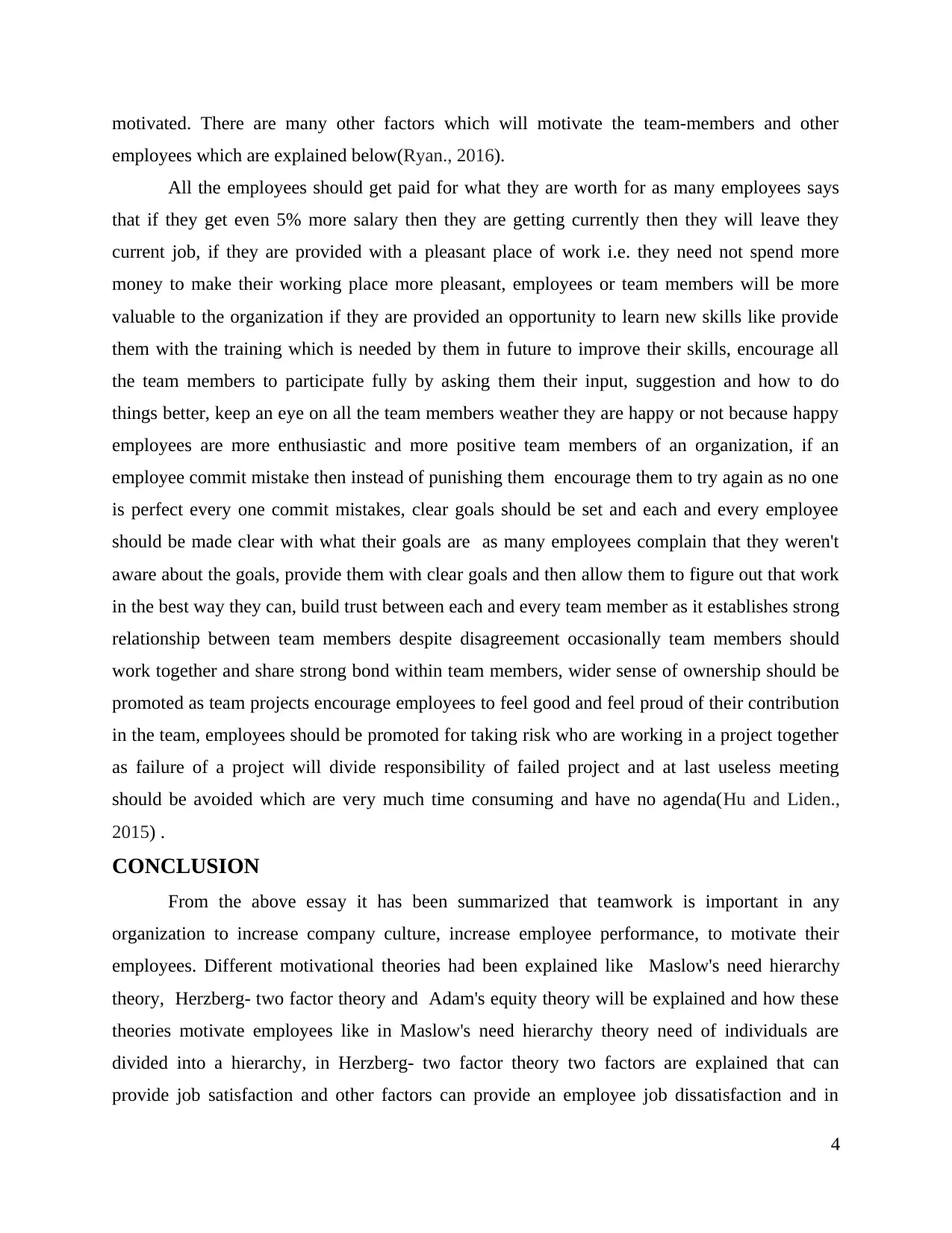
motivated. There are many other factors which will motivate the team-members and other
employees which are explained below(Ryan., 2016).
All the employees should get paid for what they are worth for as many employees says
that if they get even 5% more salary then they are getting currently then they will leave they
current job, if they are provided with a pleasant place of work i.e. they need not spend more
money to make their working place more pleasant, employees or team members will be more
valuable to the organization if they are provided an opportunity to learn new skills like provide
them with the training which is needed by them in future to improve their skills, encourage all
the team members to participate fully by asking them their input, suggestion and how to do
things better, keep an eye on all the team members weather they are happy or not because happy
employees are more enthusiastic and more positive team members of an organization, if an
employee commit mistake then instead of punishing them encourage them to try again as no one
is perfect every one commit mistakes, clear goals should be set and each and every employee
should be made clear with what their goals are as many employees complain that they weren't
aware about the goals, provide them with clear goals and then allow them to figure out that work
in the best way they can, build trust between each and every team member as it establishes strong
relationship between team members despite disagreement occasionally team members should
work together and share strong bond within team members, wider sense of ownership should be
promoted as team projects encourage employees to feel good and feel proud of their contribution
in the team, employees should be promoted for taking risk who are working in a project together
as failure of a project will divide responsibility of failed project and at last useless meeting
should be avoided which are very much time consuming and have no agenda(Hu and Liden.,
2015) .
CONCLUSION
From the above essay it has been summarized that teamwork is important in any
organization to increase company culture, increase employee performance, to motivate their
employees. Different motivational theories had been explained like Maslow's need hierarchy
theory, Herzberg- two factor theory and Adam's equity theory will be explained and how these
theories motivate employees like in Maslow's need hierarchy theory need of individuals are
divided into a hierarchy, in Herzberg- two factor theory two factors are explained that can
provide job satisfaction and other factors can provide an employee job dissatisfaction and in
4
employees which are explained below(Ryan., 2016).
All the employees should get paid for what they are worth for as many employees says
that if they get even 5% more salary then they are getting currently then they will leave they
current job, if they are provided with a pleasant place of work i.e. they need not spend more
money to make their working place more pleasant, employees or team members will be more
valuable to the organization if they are provided an opportunity to learn new skills like provide
them with the training which is needed by them in future to improve their skills, encourage all
the team members to participate fully by asking them their input, suggestion and how to do
things better, keep an eye on all the team members weather they are happy or not because happy
employees are more enthusiastic and more positive team members of an organization, if an
employee commit mistake then instead of punishing them encourage them to try again as no one
is perfect every one commit mistakes, clear goals should be set and each and every employee
should be made clear with what their goals are as many employees complain that they weren't
aware about the goals, provide them with clear goals and then allow them to figure out that work
in the best way they can, build trust between each and every team member as it establishes strong
relationship between team members despite disagreement occasionally team members should
work together and share strong bond within team members, wider sense of ownership should be
promoted as team projects encourage employees to feel good and feel proud of their contribution
in the team, employees should be promoted for taking risk who are working in a project together
as failure of a project will divide responsibility of failed project and at last useless meeting
should be avoided which are very much time consuming and have no agenda(Hu and Liden.,
2015) .
CONCLUSION
From the above essay it has been summarized that teamwork is important in any
organization to increase company culture, increase employee performance, to motivate their
employees. Different motivational theories had been explained like Maslow's need hierarchy
theory, Herzberg- two factor theory and Adam's equity theory will be explained and how these
theories motivate employees like in Maslow's need hierarchy theory need of individuals are
divided into a hierarchy, in Herzberg- two factor theory two factors are explained that can
provide job satisfaction and other factors can provide an employee job dissatisfaction and in
4
⊘ This is a preview!⊘
Do you want full access?
Subscribe today to unlock all pages.

Trusted by 1+ million students worldwide
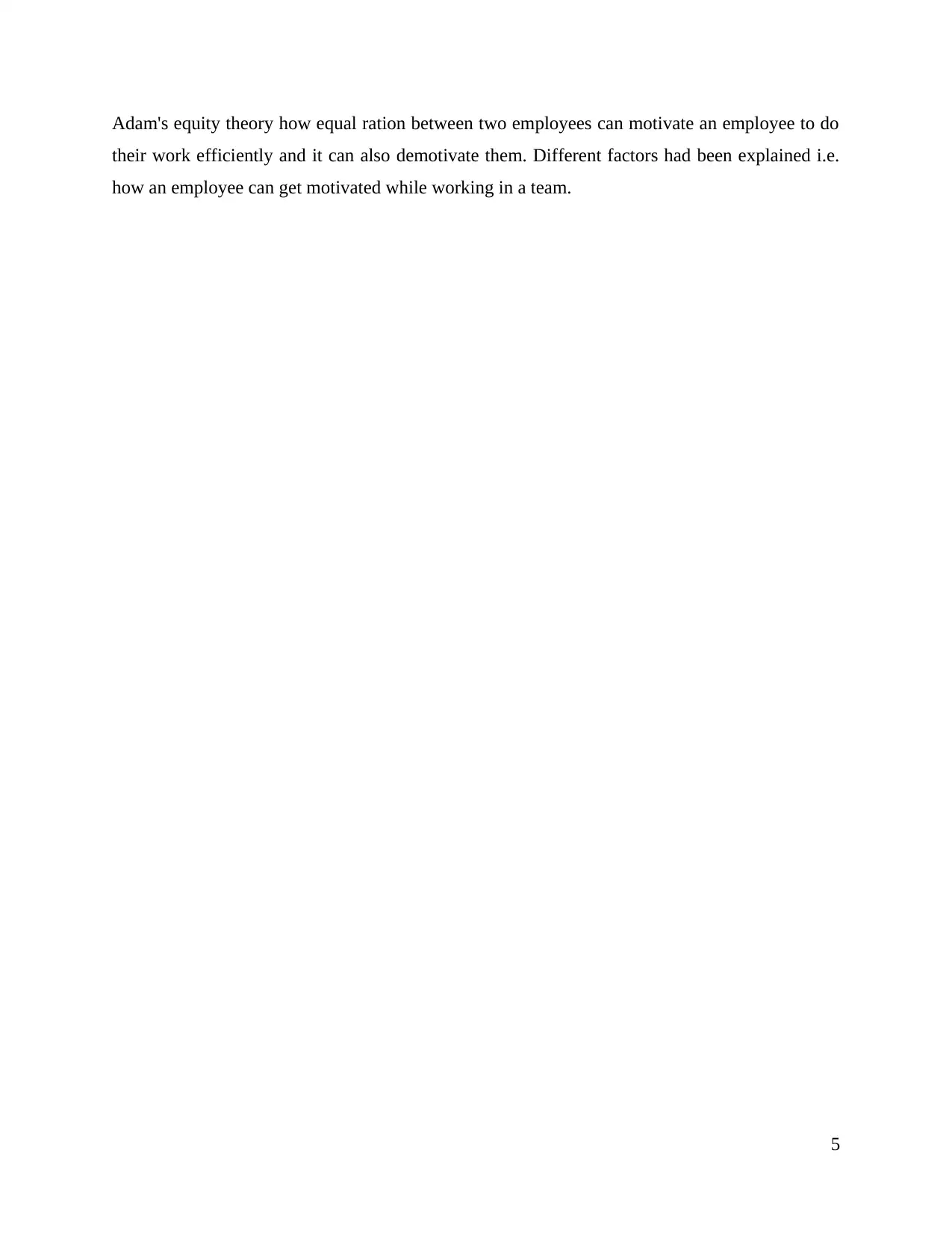
Adam's equity theory how equal ration between two employees can motivate an employee to do
their work efficiently and it can also demotivate them. Different factors had been explained i.e.
how an employee can get motivated while working in a team.
5
their work efficiently and it can also demotivate them. Different factors had been explained i.e.
how an employee can get motivated while working in a team.
5
Paraphrase This Document
Need a fresh take? Get an instant paraphrase of this document with our AI Paraphraser
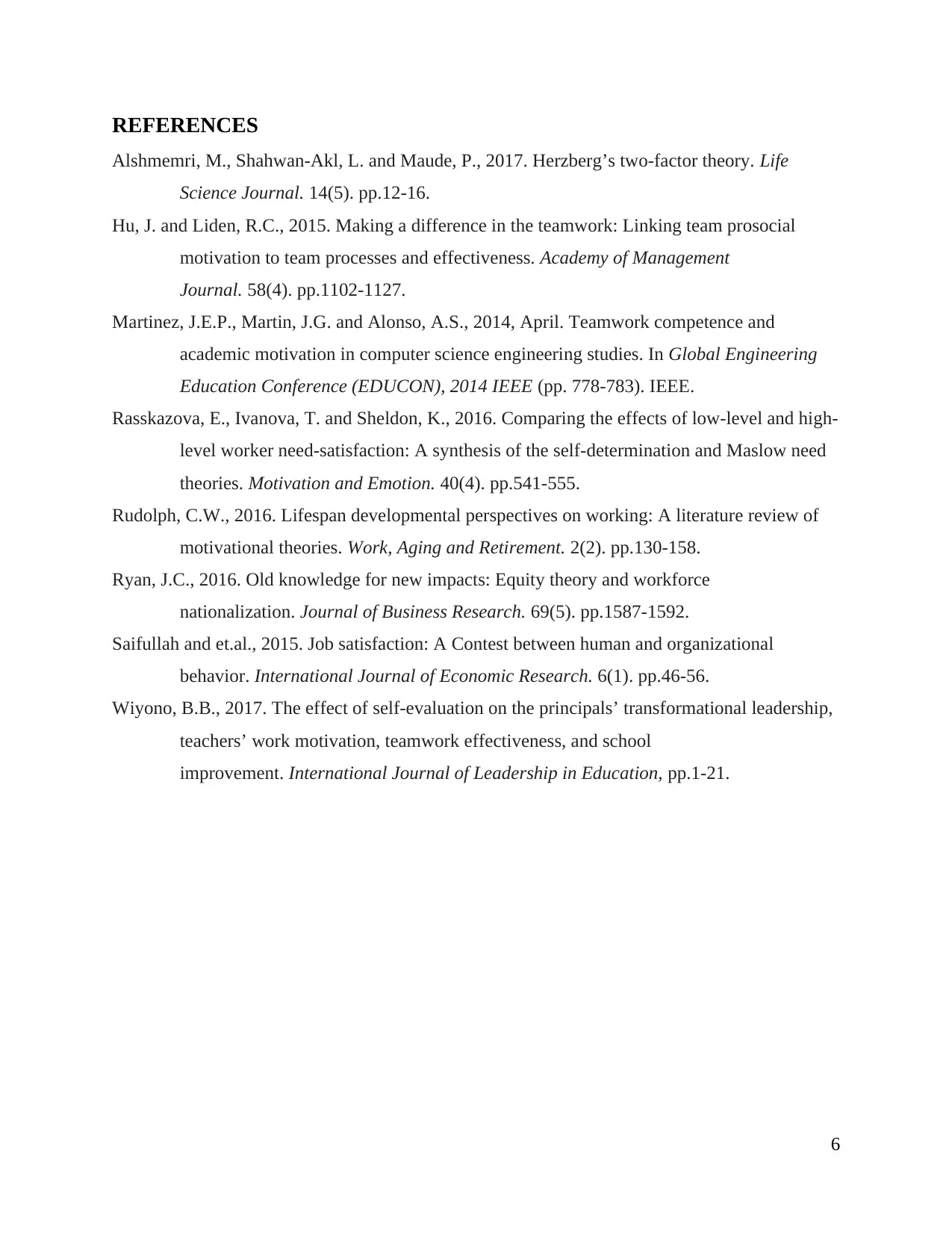
REFERENCES
Alshmemri, M., Shahwan-Akl, L. and Maude, P., 2017. Herzberg’s two-factor theory. Life
Science Journal. 14(5). pp.12-16.
Hu, J. and Liden, R.C., 2015. Making a difference in the teamwork: Linking team prosocial
motivation to team processes and effectiveness. Academy of Management
Journal. 58(4). pp.1102-1127.
Martinez, J.E.P., Martin, J.G. and Alonso, A.S., 2014, April. Teamwork competence and
academic motivation in computer science engineering studies. In Global Engineering
Education Conference (EDUCON), 2014 IEEE (pp. 778-783). IEEE.
Rasskazova, E., Ivanova, T. and Sheldon, K., 2016. Comparing the effects of low-level and high-
level worker need-satisfaction: A synthesis of the self-determination and Maslow need
theories. Motivation and Emotion. 40(4). pp.541-555.
Rudolph, C.W., 2016. Lifespan developmental perspectives on working: A literature review of
motivational theories. Work, Aging and Retirement. 2(2). pp.130-158.
Ryan, J.C., 2016. Old knowledge for new impacts: Equity theory and workforce
nationalization. Journal of Business Research. 69(5). pp.1587-1592.
Saifullah and et.al., 2015. Job satisfaction: A Contest between human and organizational
behavior. International Journal of Economic Research. 6(1). pp.46-56.
Wiyono, B.B., 2017. The effect of self-evaluation on the principals’ transformational leadership,
teachers’ work motivation, teamwork effectiveness, and school
improvement. International Journal of Leadership in Education, pp.1-21.
6
Alshmemri, M., Shahwan-Akl, L. and Maude, P., 2017. Herzberg’s two-factor theory. Life
Science Journal. 14(5). pp.12-16.
Hu, J. and Liden, R.C., 2015. Making a difference in the teamwork: Linking team prosocial
motivation to team processes and effectiveness. Academy of Management
Journal. 58(4). pp.1102-1127.
Martinez, J.E.P., Martin, J.G. and Alonso, A.S., 2014, April. Teamwork competence and
academic motivation in computer science engineering studies. In Global Engineering
Education Conference (EDUCON), 2014 IEEE (pp. 778-783). IEEE.
Rasskazova, E., Ivanova, T. and Sheldon, K., 2016. Comparing the effects of low-level and high-
level worker need-satisfaction: A synthesis of the self-determination and Maslow need
theories. Motivation and Emotion. 40(4). pp.541-555.
Rudolph, C.W., 2016. Lifespan developmental perspectives on working: A literature review of
motivational theories. Work, Aging and Retirement. 2(2). pp.130-158.
Ryan, J.C., 2016. Old knowledge for new impacts: Equity theory and workforce
nationalization. Journal of Business Research. 69(5). pp.1587-1592.
Saifullah and et.al., 2015. Job satisfaction: A Contest between human and organizational
behavior. International Journal of Economic Research. 6(1). pp.46-56.
Wiyono, B.B., 2017. The effect of self-evaluation on the principals’ transformational leadership,
teachers’ work motivation, teamwork effectiveness, and school
improvement. International Journal of Leadership in Education, pp.1-21.
6
1 out of 8
Related Documents
Your All-in-One AI-Powered Toolkit for Academic Success.
+13062052269
info@desklib.com
Available 24*7 on WhatsApp / Email
![[object Object]](/_next/static/media/star-bottom.7253800d.svg)
Unlock your academic potential
Copyright © 2020–2025 A2Z Services. All Rights Reserved. Developed and managed by ZUCOL.




